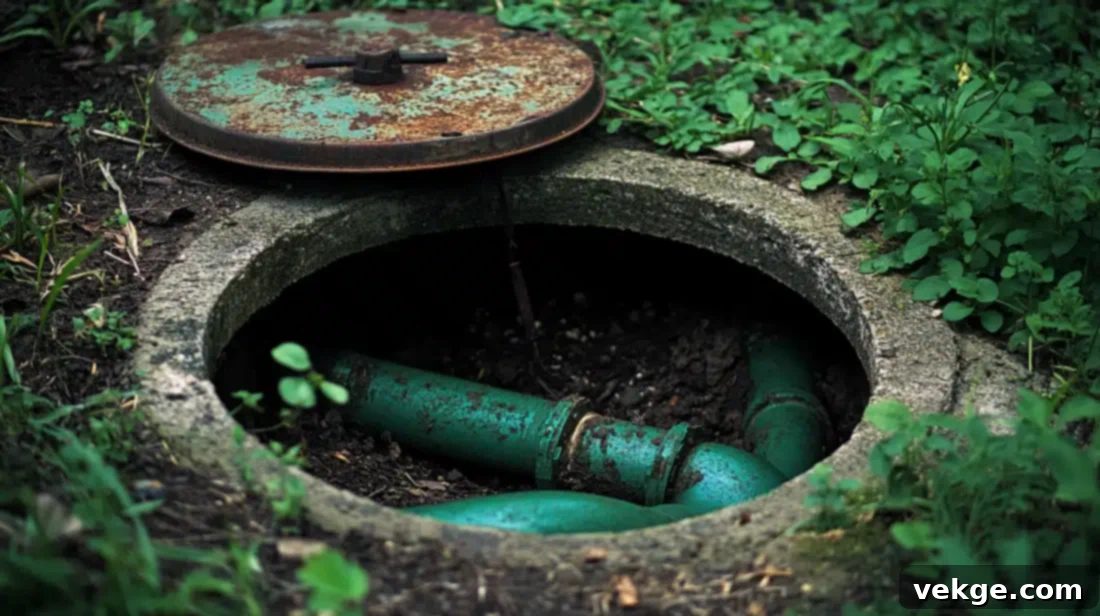Ultimate Guide to Preventing Sewer Backups: Causes, Solutions, and Expert Prevention Tips
Sewer backups are undeniably one of the most dreaded occurrences for any homeowner. They don’t just cause significant property damage; they also pose severe health hazards due to exposure to contaminated water. Many property owners find themselves caught off guard by this messy and costly problem, often without a clear understanding of its underlying causes or the most effective solutions.
This comprehensive guide aims to demystify the complex world of sewer systems and equip you with essential knowledge to protect your home and family. We will delve deep into the ten most common causes of sewer backups, ranging from insidious tree root intrusion to complex municipal system issues. More importantly, you’ll gain insights into practical, actionable solutions and proactive preventive measures that can help keep your plumbing system flowing smoothly and efficiently.
By understanding these critical factors, you will be far better prepared to maintain your sewer line, recognize early warning signs before they escalate, and take prompt, decisive action when necessary. Let’s embark on this journey to understand your sewer system better and empower you to safeguard your property against the inconvenience, damage, and potential health risks associated with sewer backups.
Main Causes of Sewer Backups: Understanding the Risks
Sewer backups represent a serious challenge for homeowners, leading to extensive property damage, foul odors, and significant health risks. A thorough understanding of their root causes is paramount for effective prevention and long-term maintenance. Below, we explore the primary culprits behind most sewer line issues.
1. Blocked or Clogged Pipes
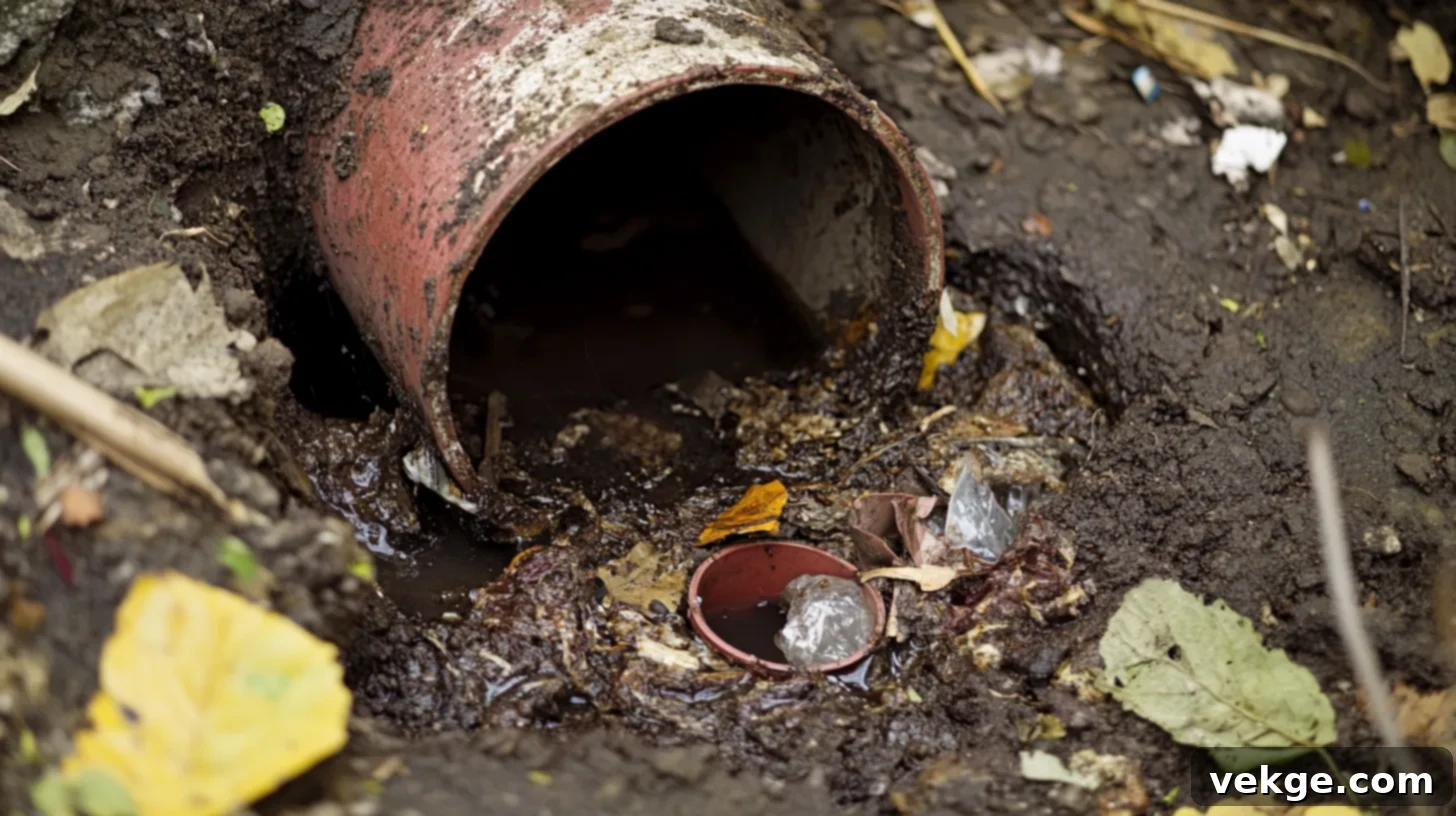
Causes of Blocked Pipes
- Accumulation of Debris: Over time, everyday items like hair, soap scum, food particles, and even mineral deposits from hard water can build up within the drains and pipes. These seemingly harmless small objects, when accidentally washed down sinks or flushed down toilets, accumulate to form substantial blockages.
- Grease and Fat Deposits: A common culprit in kitchen drain blockages, cooking oils, animal fats, and grease often get poured down the drain. While liquid when hot, these substances cool and solidify within the pipes, coating the inner surfaces. This sticky layer then acts as a magnet, trapping other debris and progressively creating larger, more resilient blockages known as “fatbergs.”
- Non-Flushable Items: Despite labels that sometimes claim otherwise, many products like “flushable” wipes, paper towels, cotton swabs, dental floss, feminine hygiene products, and even excessive amounts of toilet paper do not break down adequately in water. When flushed, they accumulate in the sewer line, forming dense obstructions that severely restrict flow and lead to backups.
Solutions for Blocked Pipes
- Strictly Avoid Flushing Inappropriate Items: Implement a household rule to only flush human waste and toilet paper. All other items, particularly “flushable” wipes and personal hygiene products, should be disposed of in a trash bin.
- Proper Grease and Oil Disposal: Never pour cooking grease or oils down the drain. Allow them to cool and solidify in a container, then dispose of them in the trash. Wiping greasy pans with a paper towel before washing can also significantly reduce grease entering your pipes.
- Perform Regular Drain Cleaning: Schedule annual professional drain cleaning services, especially if you have an older home or frequently experience slow drains. Between professional cleanings, use natural cleaning methods like a mixture of baking soda and vinegar monthly. Pouring boiling water down drains weekly can also help to dissolve minor grease buildup and keep lines clear.
- Install Drain Screens and Strainers: Place fine mesh screens or strainers in all sinks, showers, and bathtub drains. These simple devices effectively catch hair, food particles, and other debris before they can enter and clog your pipes. Remember to clean these screens regularly to maintain their effectiveness.
- Educate Household Members: Ensure everyone in your home, including children and guests, understands proper drain usage and waste disposal habits. A visual chart near sinks and toilets can serve as a helpful reminder.
- Use Enzyme-Based Cleaners: Regularly apply enzyme-based drain cleaners. Unlike harsh chemical cleaners that can damage pipes, these bio-friendly solutions use natural bacteria and enzymes to break down organic matter, grease, and food particles, keeping your pipes clear and healthy.
2. Tree Roots
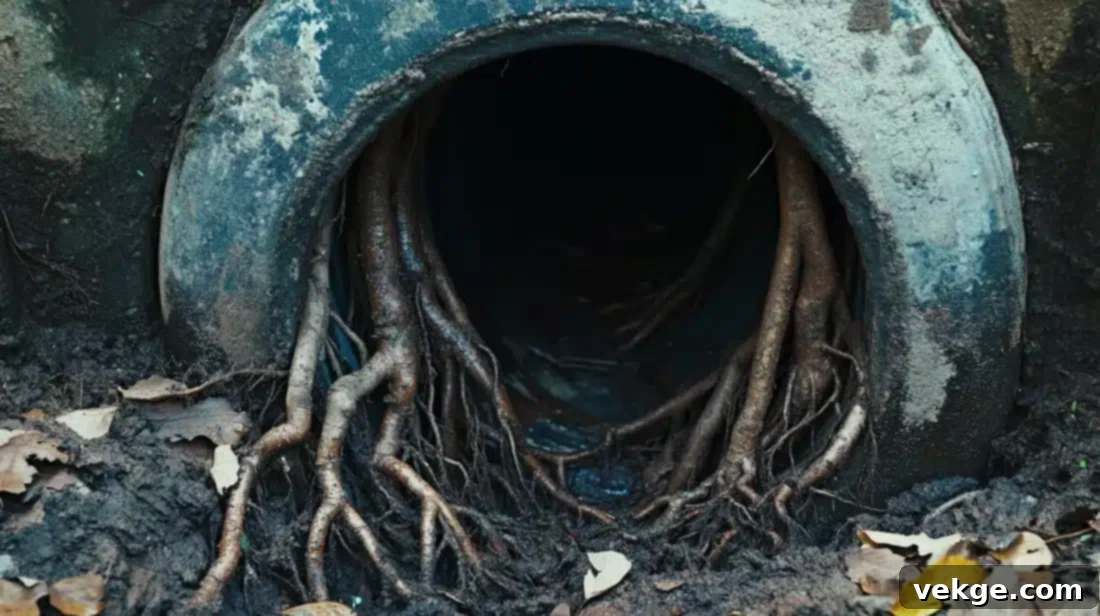
Causes of Tree Root Intrusion
- Moisture-Seeking Behavior: Tree roots are naturally programmed to seek out sources of water and nutrients to sustain the tree’s growth. Sewer lines, often buried deep in the soil, represent an ideal environment, providing a constant supply of both moisture and nutrient-rich organic matter from wastewater.
- Pipe Vulnerabilities: Even the smallest crack, loose joint, or compromised seal in a sewer pipe can serve as an entry point for eager tree roots. Older pipes, particularly those made of clay or concrete, are more porous and prone to developing these vulnerabilities, making them highly susceptible to root intrusion.
- Expansion Over Time: Once inside a pipe, roots continue to grow, expanding in size and forming dense networks. This growth not only clogs the pipe, restricting the flow of wastewater, but also exerts immense pressure on the pipe walls, leading to further cracking, shifting, and even complete collapse.
- Seasonal Changes: During dry periods or droughts, roots become even more aggressive in their search for water. This heightened seeking behavior can accelerate root intrusion and pipe damage, as the roots are more likely to exploit any available moisture source, including your sewer line.
Solutions for Tree Root Problems
- Install Root Barriers: In areas where trees are close to sewer lines, consider installing physical or chemical root barriers. Physical barriers are solid sheets placed vertically in the soil to deflect root growth, while chemical barriers release root-inhibiting chemicals.
- Regular Video Inspections: Schedule annual professional video inspections of your sewer line. This trenchless technique allows plumbers to insert a camera into the pipes, providing real-time visual assessment to detect early signs of root intrusion before they become severe blockages.
- Pipe Relining (Trenchless Repair): For pipes with minor cracks or compromised joints, pipe relining can be an effective solution. This trenchless technique involves inserting a resin-soaked liner into the damaged pipe, which is then inflated and cured to create a new, seamless pipe within the old one, sealing off entry points for roots.
- Pipe Replacement: In cases of severe root damage or multiple intrusions, replacing the affected section of the pipe may be necessary. Opt for root-resistant materials like PVC or HDPE, which have fewer joints and a smoother interior surface, making it harder for roots to penetrate.
- Professional Root Removal: If roots have already invaded your pipes, professional removal is crucial. This typically involves mechanical augers (snakes) to cut through the roots or hydro-jetting, which uses high-pressure water streams to blast away roots and clear the blockage without damaging the pipe itself.
- Strategic Tree Management: When planting new trees, choose species with less aggressive root systems and ensure they are planted at a safe distance from your sewer lines. For existing high-risk trees, consider their removal or ongoing root management.
- Routine Chemical Root Treatments: In problem areas, consider applying chemical root inhibitors every 6-12 months. These treatments contain herbicides that kill roots on contact without harming the tree itself, helping to prevent future growth inside the pipes.
3. Damaged Sewer Pipes
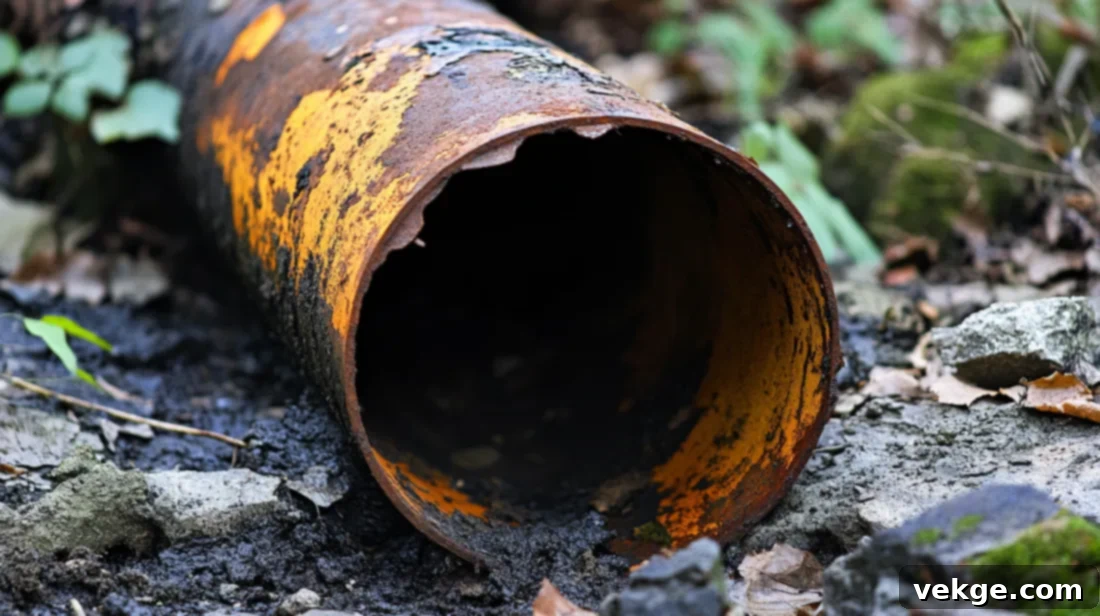
Causes of Damaged Sewer Pipes
- Earth Movements: The ground beneath your home is not always static. Soil settling, shifting, or subsidence can put immense stress on buried pipes, leading to misalignment, cracks, or even complete pipe collapses. Natural events like minor earthquakes or human activities such as nearby construction vibrations can also cause significant damage.
- Corrosion: Over time, certain pipe materials, particularly older metal pipes like cast iron or steel, can corrode due to chemical reactions with the surrounding soil or the wastewater flowing through them. This deterioration weakens the pipe walls, making them brittle and highly susceptible to cracks, leaks, and eventual collapse.
- Physical Damage: Accidental physical damage is a common cause, especially during excavation for other projects (e.g., landscaping, fence installation) where heavy machinery or digging tools can inadvertently strike and break pipes. In colder climates, repeated freeze-thaw cycles can cause water trapped in small cracks to expand, leading to larger cracks and pipe bursts.
- Age-Related Deterioration: All materials have a lifespan. Older sewer pipes made of clay, concrete, or Orangeburg (fiber conduit) are particularly prone to natural degradation over decades of use. Their materials become brittle, porous, and prone to developing cracks. Additionally, joints loosen, and seals fail, creating easy entry points for roots and allowing leaks.
Solutions for Damaged Sewer Pipes
- Regular Video Inspections: Proactive video inspections are crucial for detecting damage early. These periodic checks allow plumbers to identify cracks, misalignments, or corrosion before they lead to major backups, saving homeowners from extensive and costly repairs.
- Trenchless Repair Techniques: When pipes are damaged but not entirely collapsed, trenchless methods like pipe lining or pipe bursting offer efficient repair solutions with minimal disruption to your yard. Pipe lining involves creating a new pipe inside the old one, while pipe bursting breaks the old pipe and replaces it with a new one simultaneously.
- Complete Pipe Replacement: For severely damaged, collapsed, or extensively corroded pipes, full replacement may be the only viable option. Replacing old, failing pipes with durable, modern materials like PVC (polyvinyl chloride) or HDPE (high-density polyethylene) ensures a long-lasting, robust sewer system.
- Preventive Maintenance and Protection: In cold climates, applying protective coatings and insulating exposed sections of pipes can help prevent damage from freeze-thaw cycles. Additionally, ensuring proper soil compaction around newly installed pipes can mitigate the risk of damage from earth movements.
- Proper Installation Practices: When new pipes are installed, using appropriate bedding materials (like sand or gravel) and flexible joints can absorb ground movement and prevent stress on the pipes. This ensures a more resilient and durable sewer line from the outset.
4. Heavy Rainfall
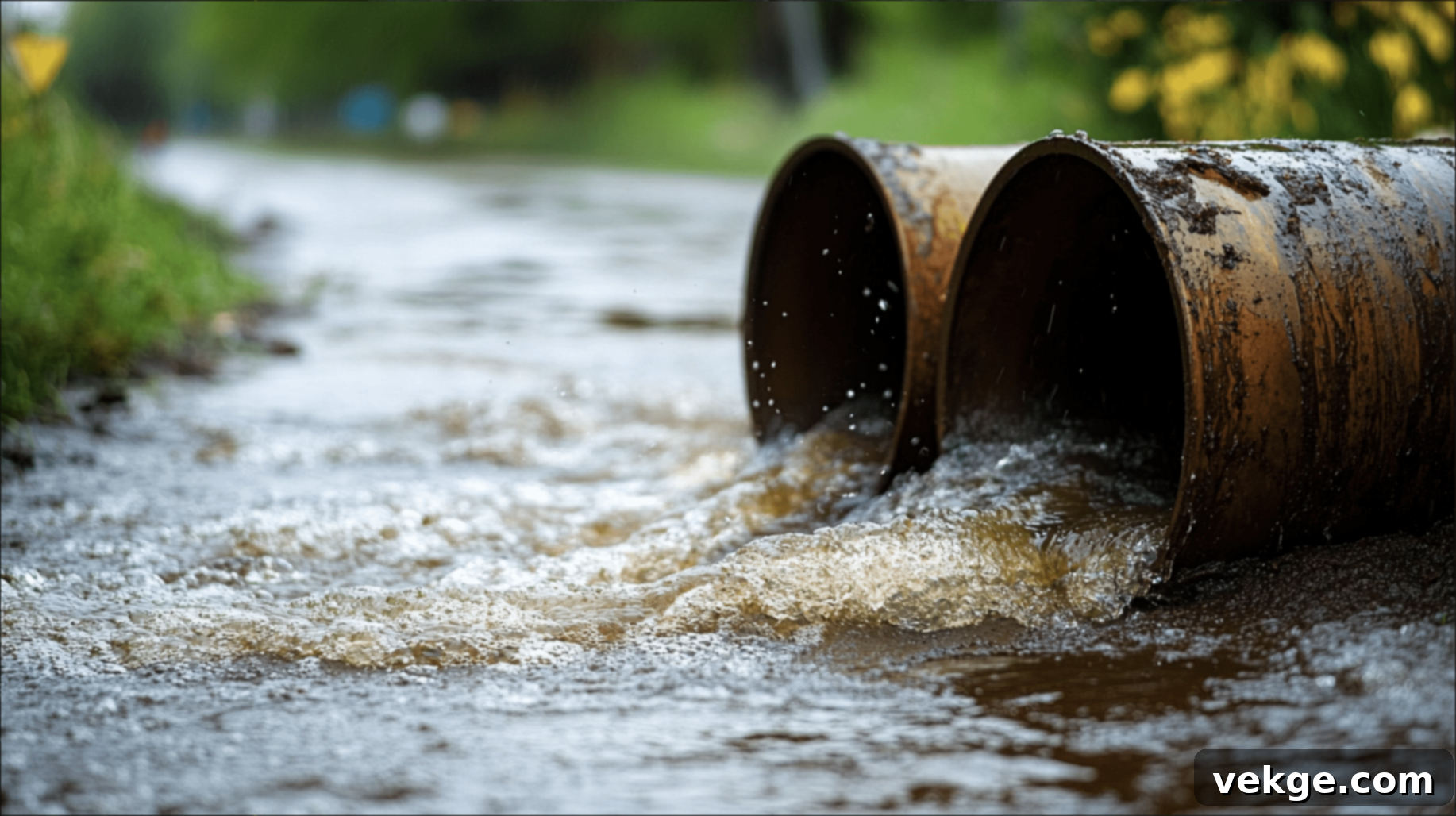
Causes of Sewer Backups Due to Heavy Rainfall
- Overwhelmed Public Sewer Systems: Many older urban areas still rely on combined sewer systems, which are designed to carry both sanitary sewage and stormwater runoff in the same pipes. During periods of heavy rainfall, the sheer volume of rainwater can quickly exceed the system’s capacity, leading to combined sewer overflows (CSOs) and backups into homes.
- Infiltration and Inflow (I&I): Even in separate sewer systems (where sanitary and stormwater lines are distinct), excessive rainwater can infiltrate cracked pipes, loose joints, or porous manholes, seeping directly into sanitary sewer lines. Improper connections, such as sump pumps or downspouts illegally directed into sanitary sewers, further exacerbate this “inflow,” overwhelming the system.
- Poor Drainage Around the Home: Surface water issues contribute significantly to basement and lower-level backups. Improperly graded yards that slope towards the foundation can direct large volumes of water directly against your home. Clogged gutters and downspouts that overflow near the house will saturate the soil around the foundation, potentially overwhelming perimeter drains or seeping into the sewer line.
Solutions for Rain-Induced Sewer Backups
- Install Backflow Valves: A backflow prevention valve is a critical device installed on your main sewer line that allows wastewater to flow out of your home but prevents it from backing up during municipal sewer overflows. Regular maintenance and testing are essential to ensure these valves function correctly when needed.
- Maintain Proper Yard Grading: Ensure the ground around your home slopes away from the foundation at a gradient of at least 6 inches for the first 10 feet. Consider creating swales (shallow ditches) or installing French drains to redirect excess rainwater away from your property and towards appropriate drainage areas.
- Disconnect Illegal Connections: It’s crucial to ensure that sump pumps, downspouts, and other stormwater drainage systems are not connected to your sanitary sewer line. These illegal connections contribute directly to municipal sewer overloads. Reroute stormwater to proper storm drains, rain gardens, or permeable surfaces.
- Regular Gutter and Downspout Maintenance: Keep your gutters and downspouts meticulously clear of leaves, debris, and other obstructions. Ensure downspouts extend at least 5-10 feet away from your foundation to effectively carry water away from your home.
- Inspect and Clean Drainage Pipes: Periodically inspect and clean any existing perimeter drains or foundation drains around your home to ensure they are free of clogs and functioning efficiently.
5. Aging Sewer Systems
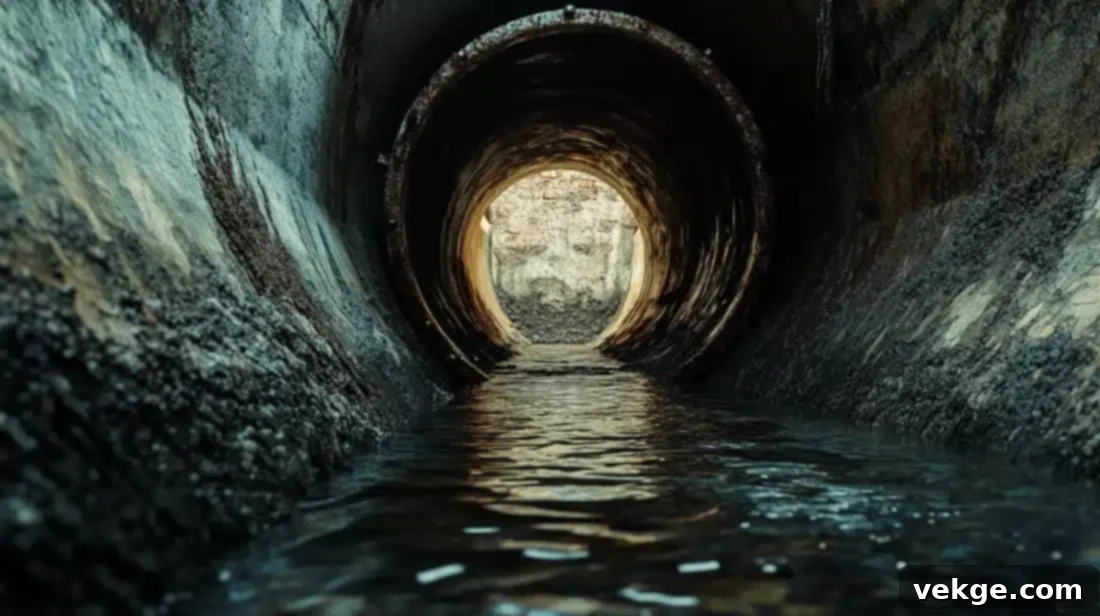
Causes of Aging Sewer System Failures
- Material Deterioration: The lifespan of sewer pipes varies greatly depending on the material. Older pipes made of clay, cast iron, or concrete naturally break down over time due to wear, chemical exposure, and ground movement. These materials become brittle, develop cracks, and can even crumble. As pipes age, joints loosen, and seals fail, creating weak points vulnerable to leaks and root intrusion.
- Corrosion: Metal pipes, particularly cast iron, are highly susceptible to corrosion. Chemical reactions with certain soil types, wastewater content, and even electrical currents can cause the pipe material to rust and deteriorate from both the inside and outside. This corrosion weakens pipe walls, leading to pitting, leaks, and eventually complete collapses.
- Outdated Design and Capacity: Many existing sewer systems were designed decades ago for much smaller populations and different water usage patterns. They may not have the capacity to handle the increased wastewater volume generated by modern homes with multiple bathrooms, high-flow appliances, and higher population densities. This can lead to frequent overloads and backups.
- Accumulated Wear and Tear: Years of constant water flow, friction from abrasive materials (like sand or grit), and the general wear and tear from carrying wastewater take their toll. This erosion can thin pipe walls and contribute to sediment buildup, further reducing the internal diameter and increasing the likelihood of blockages. Repeated minor damages compound over time, leading to significant structural integrity loss.
Solutions for Aging Sewer Systems
- Replace Old Pipes Proactively: The most definitive solution for severely aged or deteriorating pipes is replacement. Install modern, durable materials like PVC (polyvinyl chloride) or HDPE (high-density polyethylene), which are resistant to corrosion, root intrusion, and have a much longer lifespan. Consider trenchless technologies for replacement to minimize disruption to your property.
- Regular Professional Inspections: Schedule periodic video inspections to assess the condition of your aging sewer lines. These inspections can identify early signs of deterioration, such as hairline cracks, misaligned joints, or minor corrosion, allowing you to address issues before they become critical and costly failures.
- Implement Preventive Maintenance Programs: For systems that are aging but still functional, implement routine cleaning and descaling programs. Hydro-jetting can effectively remove accumulated sediment, grease, and scale, restoring pipe capacity. Applying protective coatings to the interior of pipes can also extend their lifespan by shielding them from further chemical and physical degradation.
- Advocate for Gradual System Upgrades: At the municipal level, support and advocate for long-term replacement plans for aging infrastructure. Prioritize high-risk areas for immediate attention and phased upgrades. Homeowners can also contribute by ensuring their private laterals are in good condition, reducing the burden on the main system.
6. Municipal Sewer Problems
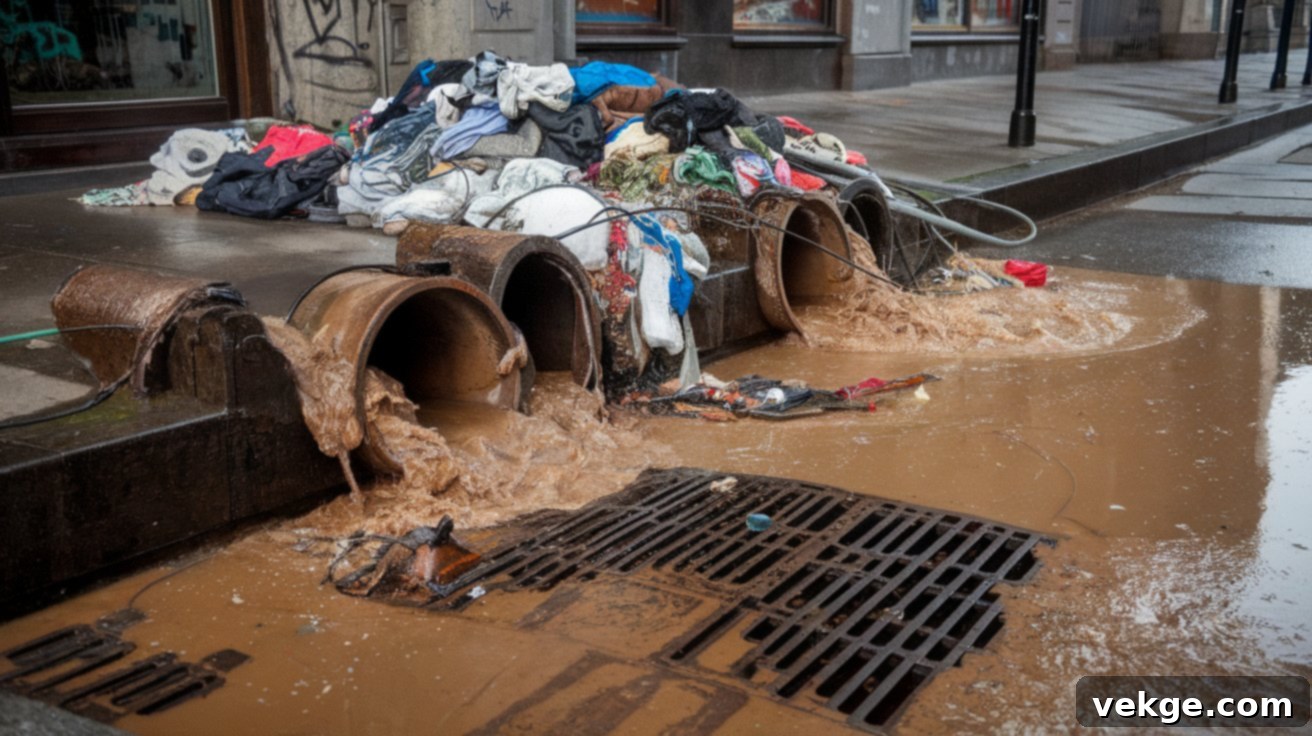
Causes of Municipal Sewer Problems Affecting Homes
- Blockages in City Sewer Lines: Just like private lines, municipal main sewer lines can suffer from severe blockages. These often result from the accumulation of large amounts of debris, congealed grease, fatbergs, and non-biodegradable materials flushed by many households and businesses. Tree root intrusion from public trees into main sewer pipes is also a significant problem.
- Aging Infrastructure: Many cities, particularly older ones, have aging sewer infrastructure with pipes that are decades or even a century old. These deteriorating or collapsing municipal sewer pipes are often made of materials that have exceeded their expected lifespan. Outdated sewer systems may also struggle to handle the increasing demands of modern urban populations.
- Capacity Issues: Rapid urban development and population growth can overwhelm existing sewer systems, especially if infrastructure upgrades have not kept pace. Combined sewer systems, designed to handle both sewage and stormwater, are particularly vulnerable during heavy rainfall, leading to capacity overloads and backups into connected homes.
- Maintenance Lapses: Inadequate or delayed municipal sewer maintenance can allow minor issues to escalate into major problems. Infrequent inspections, delayed repairs, or insufficient cleaning of main sewer lines can result in undetected damage or accumulated wear, increasing the risk of widespread backups affecting entire neighborhoods.
Solutions for Municipal Sewer Issues
- Contact Local Authorities Immediately: If you suspect a municipal sewer issue is causing your backup, the first step is to promptly report it to your municipal water or public works department. They can investigate the main sewer line and determine if the problem lies within their responsibility. Request information on any planned upgrades or maintenance in your area.
- Install a Backflow Preventer: A backflow preventer is a crucial device installed on your private sewer line to protect your home from municipal sewer overflows. It allows wastewater to flow out but automatically closes if the public sewer system pressurizes, preventing sewage from backing up into your home. Ensure it is regularly maintained and inspected for proper function.
- Stay Informed and Engaged: Subscribe to local utility notifications for updates on sewer work, infrastructure projects, or potential issues in your area. Participate in community meetings about infrastructure improvements to understand and support efforts to upgrade and maintain the municipal sewer system.
- Maintain Your Private Sewer Line: While the municipal system is outside your direct control, ensuring your private sewer line (the lateral connecting your home to the main) is in excellent condition can help minimize additional stress on the overall system. Avoid flushing non-biodegradable items and properly dispose of grease to prevent contributing to blockages that could affect the municipal network.
7. Sewer System Overload
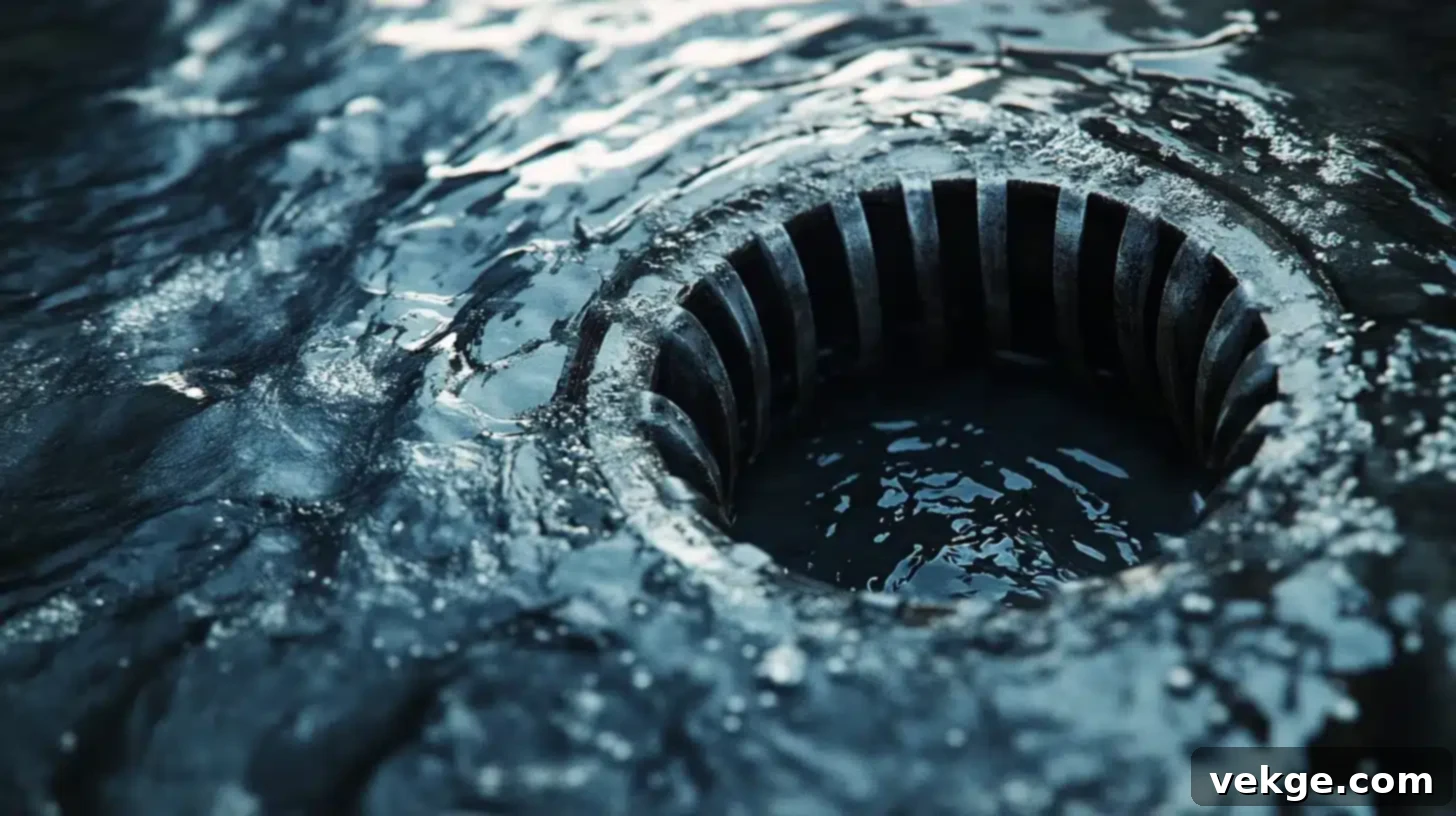
Causes of Sewer System Overload
- Excessive Water Usage: During peak hours (e.g., mornings or evenings when many people are showering, doing laundry, or running dishwashers simultaneously), the collective water usage from multiple households can temporarily overwhelm the local sewer collection system. Large-scale events or gatherings in a community can also place an unexpected strain on local systems.
- Combined Sewers: In many older cities, combined sewer systems (CSS) carry both sanitary wastewater and stormwater runoff in the same pipes. During periods of heavy rainfall or rapid snowmelt, these systems quickly become overwhelmed as the volume of water far exceeds their design capacity, leading to combined sewer overflows (CSOs) that can back up into properties.
- Outdated Infrastructure: A significant portion of existing sewer infrastructure was built many decades ago, designed for much smaller populations and lower per capita water usage. These aging systems simply do not have the pipe sizes or overall capacity to handle the demands of current population densities and modern water usage patterns, leading to frequent overloads.
Solutions for Sewer System Overload
- Practice Water Conservation: Encourage responsible water usage within your household, especially during peak hours. Install water-efficient appliances (e.g., low-flow toilets, Energy Star washing machines) and fixtures (e.g., low-flow showerheads). Even small changes can collectively reduce the load on the sewer system.
- Install Sump Pumps: For homes susceptible to basement flooding due to groundwater or overwhelmed municipal systems, a sump pump can effectively manage excess water. It pumps water away from the foundation and into a proper storm drain or outdoor area, preventing it from entering and overwhelming the sanitary sewer system. Ensure regular maintenance and testing of these pumps.
- Advocate for Separate Sewer Systems: Support and advocate for municipal upgrades to separate stormwater and sanitary sewers. This critical infrastructure improvement helps prevent combined sewer overflows during heavy rains. Engaging with local government and supporting infrastructure improvement initiatives can accelerate these necessary changes.
- Implement Smart Water Management: Consider installing rain barrels or cisterns to collect rainwater from your roof. This reduces the amount of stormwater entering the drainage system and can be reused for garden irrigation. Explore greywater systems, which reuse water from sinks, showers, and laundry for non-potable uses like toilet flushing or landscaping, further reducing the load on the sewer system.
8. Grease and Fat Build-up

Causes of Grease and Fat Build-up
- Improper Disposal Practices: The most common cause is the pouring of cooking oils, animal fats, and grease directly down kitchen drains. Many mistakenly believe that hot water will flush these substances away, but this is a temporary fix at best. Washing greasy dishes without first scraping excess fat into the trash also contributes significantly.
- Solidification in Pipes: As hot grease and fats travel through the cooler sewer pipes, they rapidly cool and solidify. This creates a sticky, waxy coating on the interior walls of the pipes. This solidified layer significantly reduces the effective diameter of the pipe and acts as a powerful adhesive.
- Accumulation Over Time: Once the sticky layer of solidified grease forms, it acts as a magnet for other debris. Food particles, hair, soap scum, and non-flushable items readily adhere to the grease, forming increasingly stubborn and dense blockages, often referred to as “fatbergs.” This gradual accumulation narrows the pipe diameter, eventually leading to a complete blockage and sewer backup.
Solutions for Grease and Fat Build-up
- Proper Grease Disposal: The golden rule is to never pour grease or oils down the drain. Allow cooking grease to cool and solidify in a disposable container (e.g., an old milk carton, tin can, or jar), then scrape it into the trash. Dedicated grease traps for collection can also be used.
- Pre-Cleaning Dishes: Before washing, scrape all food scraps and excess grease from plates, pans, and utensils into the trash or compost bin. Wiping greasy pans with a paper towel can remove a significant amount of residue before they are washed.
- Use Sink Strainers: Install sink strainers in your kitchen sink to catch any food particles that might otherwise go down the drain. Clean these strainers regularly to prevent them from becoming clogged themselves.
- Regular Maintenance: Pouring hot water down your drains weekly can help to dissolve minor grease buildup before it hardens. For a more proactive approach, use enzyme-based drain cleaners monthly. These biological solutions break down grease and organic matter without the corrosive effects of harsh chemical drain cleaners.
- Educate Household Members: Ensure everyone in your household understands the importance of proper grease disposal. Post simple reminders near the kitchen sink to reinforce these habits.
9. Flushing Non-Degradable Items

Causes of Blockages from Non-Degradable Items
- Improper Disposal Habits: A widespread misconception is that if an item fits down the toilet, it can be flushed. This leads to the flushing of items like “flushable” wipes (which often do not break down in sewer systems), feminine hygiene products (pads, tampons), cotton swabs, dental floss, paper towels, and facial tissues. These items are designed to be durable and absorbent, not to disintegrate like toilet paper.
- Lack of Awareness and Misleading Labels: Many consumers are unaware of the harm these items cause, often misled by product labels claiming certain wipes are “flushable.” These products may clear your toilet bowl but accumulate further down the sewer line, combining with grease and other debris to form stubborn clogs.
- Accumulation Over Time: Unlike toilet paper, which is specifically designed to dissolve rapidly in water, non-degradable items retain their form. Over time, these items build up in the intricate bends and narrower sections of pipes, creating dense blockages that severely restrict water flow and ultimately lead to significant sewer backups.
Solutions for Preventing Blockages from Non-Degradable Items
- Strict Proper Disposal Practices: Adhere to the “only flush the 3 Ps” rule: pee, poop, and (toilet) paper. All other items, without exception, should be disposed of in a trash bin. This is the single most effective way to prevent these types of blockages.
- Educate All Household Members: Ensure everyone in your household, including children and guests, is aware of proper flushing habits. Place small, covered trash bins in all bathrooms as a convenient option for disposing of non-flushable items. Consider posting simple reminders near toilets.
- Install Drain Screens: While primarily for sinks and showers, for toilets, maintaining a clean and clear bowl environment and avoiding dropping items accidentally is the best defense. For other drains, screens prevent larger items from entering.
- Regular Professional Pipe Cleaning: Even with careful disposal habits, some buildup can occur. Scheduling periodic professional pipe cleaning can help clear any minor accumulations before they become major blockages caused by non-degradable materials.
10. Improper Disposal of Food Waste
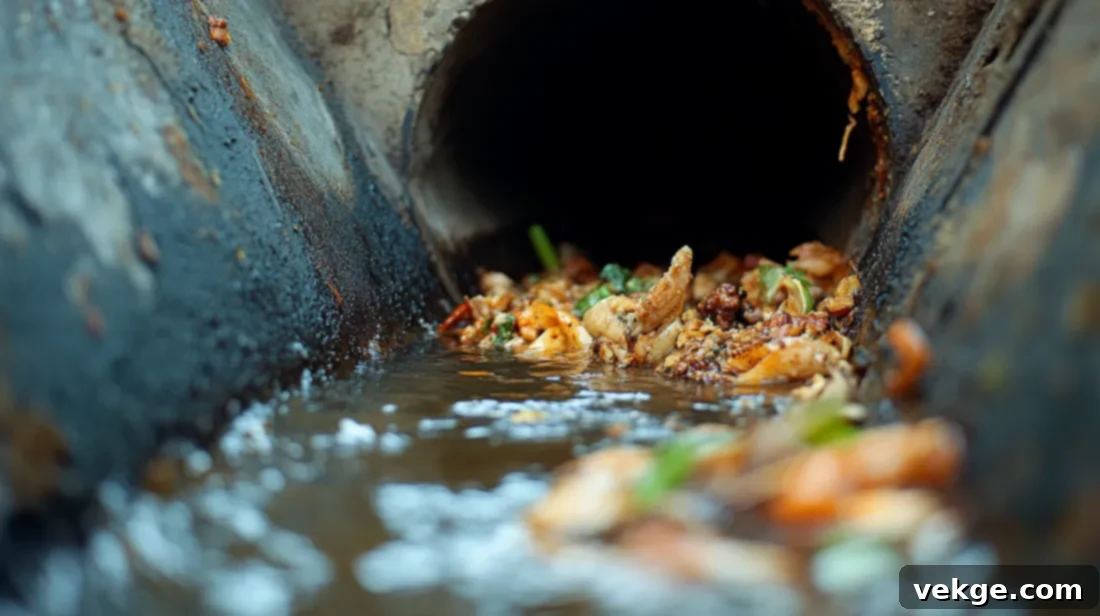
Causes of Blockages from Food Waste
- Accumulation of Food Particles: While garbage disposals are designed to grind food, they are not infallible. Large food scraps, especially fibrous or starchy items like potato peels, banana peels, coffee grounds, eggshells, and pasta, can overwhelm the disposal or accumulate in the pipes further down the line, forming dense, sticky blockages.
- Overuse or Improper Use of Garbage Disposals: Grinding excessive amounts of food waste at once, or attempting to dispose of items that are explicitly not recommended for disposals (e.g., bones, fruit pits, corn husks, stringy vegetables), can lead to clogs within the disposal unit itself or in the drainpipe.
- Interaction with Grease: When food waste, especially starchy or fibrous types, mixes with grease and oils that have been improperly disposed of, it creates a formidable blockage. The grease acts as a binder, creating a dense, almost concrete-like obstruction that is extremely difficult to dislodge and can rapidly narrow the pipe diameter.
- Flushing Food Scraps Down Toilets: Sometimes, people attempt to flush food scraps down toilets, assuming the powerful flush will clear them. However, toilet pipes are designed for human waste and toilet paper only. Food scraps, particularly those that don’t break down easily, will quickly accumulate and cause blockages in the toilet or the main sewer line.
Solutions for Preventing Food Waste Blockages
- Use Garbage Disposals Properly: Always run cold water before, during, and for at least 30 seconds after using your garbage disposal. This helps flush food particles completely through the trap and into the sewer line. Grind only small amounts of appropriate food waste at a time. Avoid putting stringy, fibrous, or starchy foods into the disposal.
- Avoid Dumping Large Quantities of Food Waste: The best practice is to scrape plates, bowls, and cooking utensils into the trash or compost bin before washing them. This significantly reduces the amount of food waste entering your drains.
- Utilize Sink Strainers Effectively: Place sink strainers in your kitchen sink to catch any stray food particles that might escape during washing. Clean these strainers regularly to prevent them from becoming clogged and hindering drainage.
- Adhere to Proper Grease Disposal: As mentioned previously, cool and dispose of all cooking oils and grease in the trash, not down the drain. Wipe greasy pans with paper towels before washing to minimize residue. This prevents the formation of sticky matrices where food waste can accumulate.
- Educate Household Members on Waste Sorting: Teach everyone in your home about proper disposal methods for different types of food waste. Encourage composting for appropriate food scraps as an environmentally friendly alternative to sending them down the drain or into landfills.
Tips to Prevent Sewer Backups: Proactive Measures for a Healthy Home
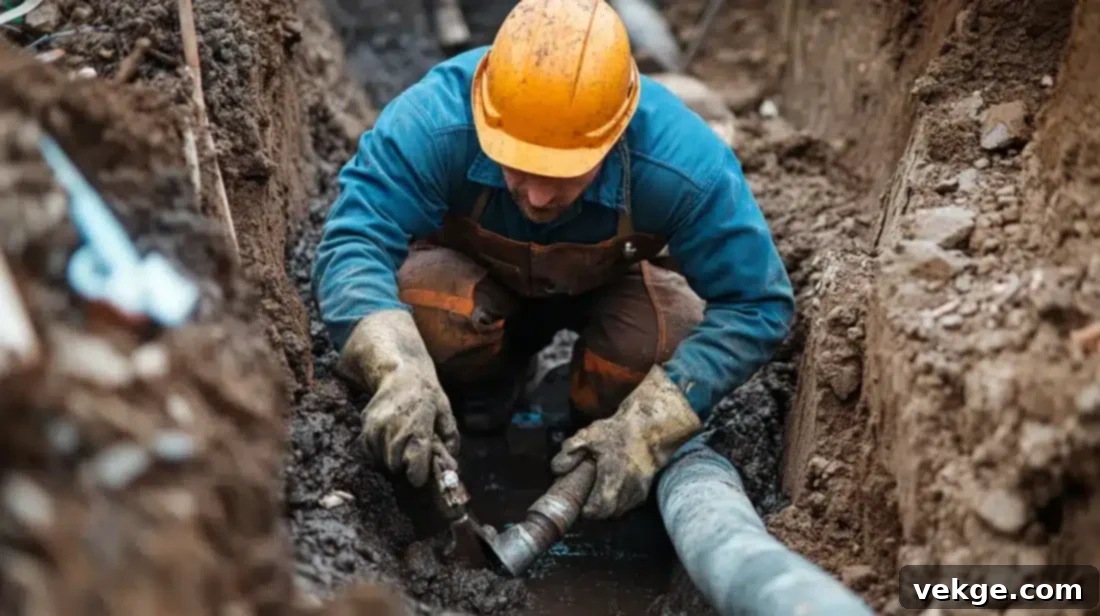
Preventing sewer backups is not just about avoiding a messy situation; it’s crucial for maintaining a healthy, hygienic home environment and sidestepping potentially costly and disruptive repairs. By implementing the following preventive measures diligently, you can significantly reduce the risk of sewer problems and ensure your plumbing system functions smoothly and reliably for years to come.
Regular Professional Sewer Inspections
- Annual Check-ups: Schedule annual professional sewer line inspections, especially if your home is older or has mature trees nearby. These inspections utilize advanced video camera technology, allowing plumbers to visually assess the interior condition of your sewer pipes.
- Early Detection is Key: Video inspections are invaluable for detecting early signs of problems such as hairline cracks, misaligned pipe joints, the initial stages of tree root intrusion, or the buildup of grease and debris. Identifying these issues early allows for targeted interventions before they escalate into major, expensive backups.
- Maintain Records: Keep detailed records of all inspections, including video footage and reports. This documentation helps track changes in your sewer line’s condition over time, providing a valuable history for future maintenance or troubleshooting.
Conscientious Waste Disposal Habits
- Educate Your Household: Ensure every member of your household is well-informed about proper waste disposal practices. The “only flush the 3 Ps” (pee, poop, and toilet paper) rule should be strictly enforced.
- No “Flushable” Wipes or Hygiene Products: Never flush “flushable” wipes, feminine hygiene products, cotton swabs, dental floss, or paper towels. These items do not break down in water and are major contributors to pipe blockages.
- Proper Grease and Oil Disposal: Avoid pouring grease, cooking oils, or large food particles down any drain. Allow grease to cool and solidify, then dispose of it in the trash. Scrape plates clean before washing.
- Utilize Trash Bins: Place small, covered trash bins in all bathrooms and kitchens for convenient disposal of non-flushable items and food scraps.
- Consider Composting: For environmentally conscious disposal, consider composting appropriate food scraps instead of relying solely on garbage disposals, which can still contribute to pipe buildup over time.
Install and Maintain Backflow Valves
- Essential Protection: Install backflow prevention devices on your main sewer line and any basement drains (e.g., floor drains, laundry tubs) if your area is prone to municipal sewer surcharges or heavy rainfall. These critical valves are designed to allow sewage to flow out of your home but automatically prevent it from backing up into your property during an overload of the public sewer system.
- Regular Maintenance and Testing: A backflow valve is only effective if it’s functioning correctly. Schedule regular maintenance and testing with a qualified plumber to ensure the device is clear of debris and operating optimally.
- Professional Installation: Due to the importance of these devices, professional installation is highly recommended to ensure compliance with local codes and optimal performance.
Implement Routine Plumbing Maintenance
- Natural Drain Cleaning: Monthly, clean drains using natural methods like a mixture of baking soda and vinegar. Pour baking soda down the drain, follow with vinegar, let it sit for 20-30 minutes, then flush with hot water. This helps to break down minor organic buildup.
- Enzyme-Based Cleaners: Use enzyme-based drain cleaners quarterly. These biological solutions are safer for your pipes and the environment than harsh chemical cleaners, effectively breaking down grease, proteins, and carbohydrates.
- Annual Professional Drain Cleaning: Schedule professional drain cleaning annually. This can involve hydro-jetting, which uses high-pressure water to thoroughly scour the inside of your pipes, removing built-up debris, grease, and even minor root intrusions.
- Maintain Outdoor Drainage: Regularly clean and inspect outdoor drainage systems, including gutters and downspouts, ensuring they are free of debris and direct water away from your foundation. Check that yard grading slopes away from your home.
- Promptly Address Minor Issues: Don’t ignore slow drains or gurgling sounds. Addressing minor plumbing issues promptly can prevent them from escalating into larger, more severe sewer problems.
By diligently implementing these preventive measures, homeowners can significantly reduce the risk of experiencing disruptive and damaging sewer backups. Regular attention to these aspects of your home’s plumbing system can save considerable time, money, and stress in the long run by proactively avoiding major sewer issues and maintaining a healthy living environment.
What to Do if a Sewer Backup Occurs: Immediate Steps for Safety and Mitigation
Despite all preventive efforts, a sewer backup can still occur. Knowing how to react quickly and safely is paramount to minimize damage and protect your health. Here are the immediate steps to take:
Ensure Safety First
- Evacuate and Isolate: Immediately evacuate the affected area and ensure all family members and pets are kept away from the contaminated zone. Sewage water contains harmful bacteria, viruses, and other pathogens that pose serious health risks.
- Avoid Contact: Under no circumstances should you come into direct contact with the sewage water. If contact is unavoidable, wear robust protective gear.
Turn Off Utilities
- Electrical Breaker: Locate your main electrical breaker and shut off power to the affected area. This is crucial to prevent electrical shock hazards, especially if water has come into contact with outlets or appliances.
- Water Supply: Turn off your home’s main water supply valve to prevent any additional water from entering the plumbing system and exacerbating the backup.
- Gas (If Safe): If you suspect any gas lines might be compromised or if the backup is near gas appliances, and it’s safe to do so, turn off your gas supply. If you smell gas, evacuate immediately and call your gas provider.
- Unplug Devices: Unplug all electrical devices and appliances from the affected area to prevent damage and reduce shock risk.
Ventilate the Space
- Open Windows and Doors: Open all windows and doors in and around the affected area to promote airflow and begin ventilating the space. This helps to reduce strong odors and disperse harmful fumes that may be present.
- Use Fans (Carefully): You can use box fans to aid ventilation, but ensure they are placed safely away from any standing water to avoid electrical hazards. Do not use your central air conditioning or heating system, as this can spread contaminants and odors throughout your home.
Wear Protective Gear
- Full Protection: If you must enter the affected area (e.g., to turn off utilities), wear heavy-duty rubber boots, waterproof gloves, eye protection (goggles), and a N95 or P100 face mask to protect against airborne contaminants and splash exposure.
- Post-Use Care: After use, all protective gear should be thoroughly cleaned and disinfected or, if disposable, discarded properly to prevent cross-contamination.
Call Professionals Immediately
- Licensed Plumber: Contact a licensed and reputable plumber or a drain cleaning service right away. They have the expertise and specialized equipment (e.g., video inspection cameras, hydro-jetters) to identify the cause of the backup and perform the necessary repairs safely.
- Sewage Cleanup Service: For effective remediation, also call a professional sewage cleanup and restoration service. These specialists are equipped to safely remove contaminated materials, thoroughly clean and disinfect the area, and properly dry out your property to prevent mold growth.
- Notify Local Authorities: If you suspect the sewer backup originates from a municipal main line issue (e.g., if multiple neighbors are experiencing similar problems), notify your local public works or water department.
Notify Your Insurance Company
- Contact Insurer Promptly: As soon as the immediate emergency is under control, contact your homeowner’s insurance company to report the damage. Understand your policy’s coverage for sewer backups, as it may require a specific endorsement.
- Document Damage: Thoroughly document all damage with clear photos and videos before any cleanup begins. Keep detailed records of all expenses, including emergency repairs, cleanup services, and replacement costs, as well as receipts for professional services. This documentation will be crucial for your insurance claim.
Remember, sewer backups pose serious health risks and can lead to extensive structural damage if not handled correctly. While these immediate steps can mitigate some dangers, professional intervention is absolutely crucial for thorough remediation, ensuring safety, and preventing future occurrences. Do not attempt extensive cleanup on your own due to the hazardous nature of sewage.
Conclusion
Sewer backups can quickly transform your comfortable home into a stressful and potentially unhealthy environment. However, as this guide has shown, armed with comprehensive knowledge, you possess the power to prevent most of these issues before they start. From understanding the insidious nature of clogged pipes and invasive tree roots to recognizing the vulnerabilities of aging infrastructure and municipal challenges, comprehending these problems empowers you to take decisive and proactive action.
Your best defenses against sewer backups are consistent vigilance and proactive measures. This includes committing to regular professional inspections of your sewer line, adopting meticulous waste disposal habits within your household, and performing routine plumbing maintenance. Remember, the effort you invest today is not just about avoiding future inconvenience; it’s fundamentally about safeguarding your family’s health, preserving the structural integrity of your property, and protecting your home’s long-term value.
In the event of an unavoidable backup, knowing the immediate steps to ensure safety and mitigate damage, followed by prompt professional intervention, is crucial. And don’t forget the importance of thoroughly documenting everything for insurance purposes, providing you with a crucial safety net.
By implementing the strategies and insights we’ve discussed throughout this comprehensive guide, you will significantly reduce your risk of experiencing the nightmare of sewer backups. Ready to take the next critical step towards a secure and healthy home? Schedule a professional inspection of your sewer system today and invest in your peace of mind.
